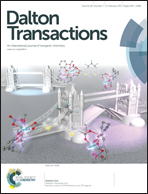Solid-phase cyclopalladation in S,C,S′-pincer systems: rising alternative for synthesis in solution†
Abstract
In pursuit of a new and simple approach to complex organometallic systems, the possibility of formation of a palladium–carbon bond in the solid state via direct cyclopalladation has been studied toward several S,C,S′-pincer ligands with thione sulfur donors of different nature. It is found that mixtures of the ligand and PdCl2(NCPh)2 obtained by the manual grinding of reactants in a mortar efficiently undergo solid-phase cyclometalation upon heating in open test tubes without the addition of a solvent to afford the desired pincer-type products in high yields. In the case of the most active bis(thiocarbamoyl) ligand, solid-phase cyclopalladation proceeds even at room temperature. For the challenging bis(thiophosphoryl) derivative, the preformed non-metallated complexes can be successfully used as a starting material to essentially enhance the yield of the desired pincer complex compared to the conventional synthesis in solution. The solid-phase transformation is followed by IR spectroscopy and SEM analysis. The results obtained show that the suggested solid-phase methodology can serve as a powerful alternative to conventional synthesis of pincer complexes in solution.


 Please wait while we load your content...
Please wait while we load your content...